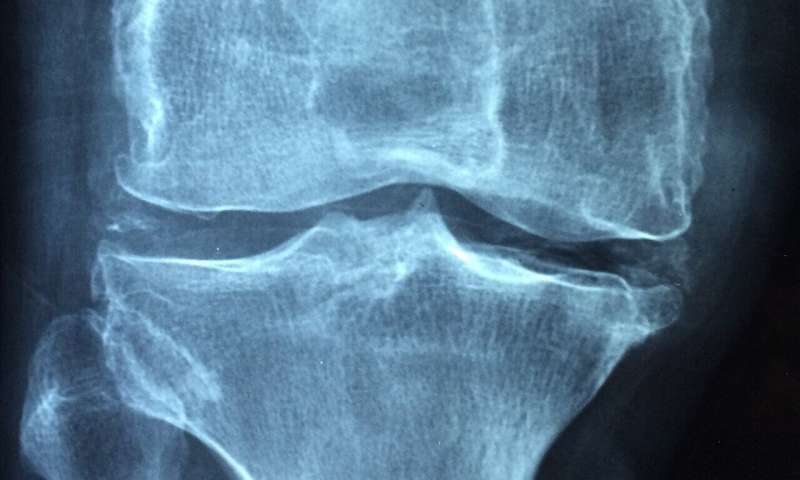
Credit: CC0 Public Domain
Birmingham researchers have shown that PEPITEM, a naturally-occurring peptide (small protein), holds promise as a new therapeutic for osteoporosis and other disorders that feature bone loss, with distinct advantages over existing drugs.
PEPITEM (Peptide Inhibitor of Trans-Endothelial Migration) was first identified in 2015 by University of Birmingham researchers.
The latest research, published in Cell Reports Medicine, shows for the first time that PEPITEM could be used as a novel and early clinical intervention to reverse the impact of age-related musculoskeletal diseases, with data demonstrating that PEPITEM enhances bone mineralization, formation and strength, and reverses bone loss in animal models of disease.
Bone is constantly formed, reformed, and remodeled throughout life, and up to 10% of human bone is replaced annually through a complex interplay between two cell types—osteoblasts, which form bone, and osteoclasts, which break down bone. Disturbances to this tightly orchestrated process are responsible for features of diseases such as osteoporosis and rheumatoid arthritis, which show excessive bone breakdown, or ankylosing spondylitis, where abnormal bone growth occurs.
The most commonly used osteoporosis therapies (bisphosphonates) target osteoclasts to prevent further bone loss. Although there are new ‘anabolic’ agents that can promote new bone formation, these have limitations in their clinical use, with teriparatide (parathyroid hormone, or PTH) only being effective for 24 months and romosozumab (anti-sclerostin antibody) being associated with cardiovascular events.
Therefore, there is a clear case for developing new therapies to stimulate bone repair in age-related musculoskeletal diseases, of which osteoporosis is the most common.
Researchers led by Dr. Helen McGettrick and Dr. Amy Naylor, including Dr. Jonathan Lewis and Kathryn Frost, from the Institute of Inflammation and Aging at the University of Birmingham and Dr. James Edwards from Nuffield Department of Orthopedics, Rheumatology and Musculoskeletal Sciences at the University of Oxford set out to investigate the potential therapeutic impact of PEPITEM in these disease states.
PEPITEM is a naturally occurring short protein (peptide) produced in the body and found circulating in everyone at low levels.
The research findings demonstrated that PEPITEM regulates bone remodeling and that increasing the amount present in the body stimulates bone mineralization in ‘young bones’ that are not in a diseased or pre-osteoporotic state, and that this translates to an increase in bone strength and density similar to current standard of care drugs (bisphosphonates and PTH).
However, the key test for a potential new therapeutic is its ability to target the natural repair process that is compromised by age, or inflammatory disease.
Here the researchers showed that giving additional PEPITEM limits bone loss and improves bone density in animal models of menopause, which is a common trigger for osteoporotic bone loss in humans. Their studies also showed similar findings in models of inflammatory bone disease (arthritis), where PEPITEM significantly reduced bone damage and erosion.
These findings were underscored by studies using human bone tissue, harvested from older patients during joint surgery. These studies showed cells from older individuals respond to PEPITEM, significantly increasing the maturation of osteoblasts, and their ability to produce and mineralize bone tissues.
Their cell and tissue culture work showed PEPITEM has a direct effect on osteoblasts to promote bone formation, by increasing the activity of osteoblasts rather than their number. Further studies identified the NCAM-1 receptor as the specific receptor for PEPITEM in osteoblasts, and strongly suggested the NCAM-1- b-catenin signaling pathway is responsible for the upregulation of osteoblast activity. This receptor, and the pathway, are distinct from PEPITEM receptors that have been previously described in other tissues.
The researchers also investigated PEPITEM’s effect on osteoclasts and bone resorption. Here, mouse studies showed PEPITEM significantly reduces the number of osteoclasts, leading to reduced bone mineral resorption. The researchers subsequently demonstrated that the reduction in osteoclast activity is the result of a soluble substance released locally in bone tissues by osteoblasts ‘activated’ by PEPITEM.
Dr. Helen McGettrick said, “While the most commonly used drugs, bisphosphonates, work by blocking the action of osteoclasts, PEPITEM acts by swinging the balance in favor of bone formation, without impacting the ability of osteoclasts to resorb regions of damaged or weak bone tissue via normal bone remodeling.”
Helen Dunster, the Business Development Manager who has curated the intellectual property associated with PEPITEM for the last eight years says, “PEPITEM is the subject of a number of patent families relating to its activity in inflammation and inflammatory immune-mediated, bone and obesity related diseases, and also comprising of smaller PEPITEM pharmacophores.
“A US patent application (US18488234) covering the use of PEPITEM in the treatment or prevention of bone disease, has a priority filing date of 8/10/2019.”
More information:
Therapeutic avenues in bone repair: Harnessing an anabolic osteopeptide (PEPITEM) to boost bone growth and prevent bone loss, Cell Reports Medicine (2024). DOI: 10.1016/j.xcrm.2024.101574. www.cell.com/cell-reports-medi … 2666-3791(24)00266-0
Citation:
Naturally-occurring peptide shows promise as new therapeutic in bone repair (2024, May 21)
retrieved 21 May 2024
from https://medicalxpress.com/news/2024-05-naturally-peptide-therapeutic-bone.html
This document is subject to copyright. Apart from any fair dealing for the purpose of private study or research, no
part may be reproduced without the written permission. The content is provided for information purposes only.
>>> Read full article>>>
Copyright for syndicated content belongs to the linked Source : Medical Xpress – https://medicalxpress.com/news/2024-05-naturally-peptide-therapeutic-bone.html










